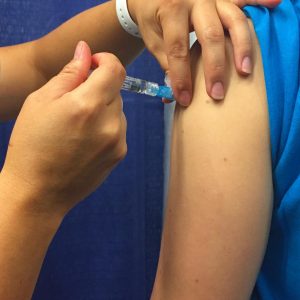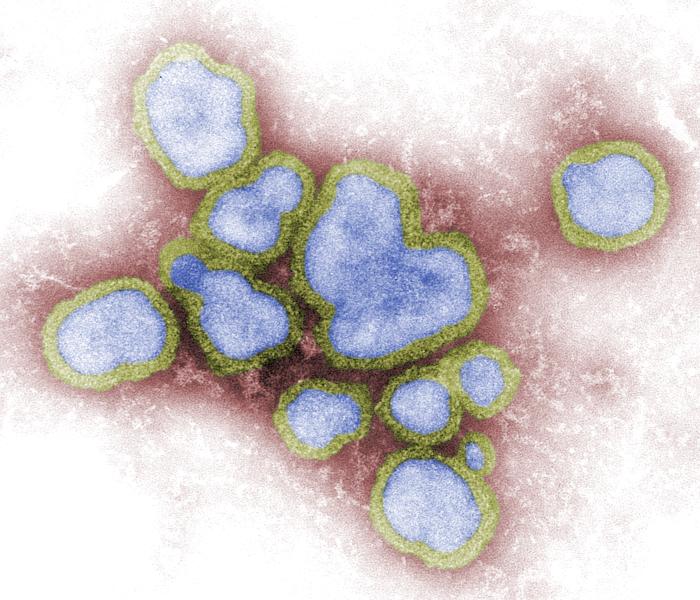During the Centers for Disease Control and Prevention (CDC) update of the influenza situation in the US to date on Friday, the issue of vaccines was a major topic. Director, Influenza Division, National Center for Immunization and Respiratory Diseases, Dan Jernigan, M.D., M.P.H. said the following:

Imahe/NIAID
“Vaccination is our main tool to prevent influenza infection, and CDC recommends that vaccination efforts continue as long as influenza viruses are circulating. It about takes two weeks for protection from vaccination to set in, but as I said, we have a lot of flu season to get through still.
“We will see other flu viruses start to circulate later during the flu season and most flu vaccines protect against all four of those circulating viruses. The B viruses are still to really show up and take off. So getting a vaccine would help cover them as well.
LIMITED TIME 30% Off sitewide + Free Shipping on orders over $49+ at CVS
“The manufacturers are reporting that they’ve shipped more than 151 million doses of flu vaccine so there should be product available to folks. One tool you can use is to go to the CDC website and look up the vaccine finder. This is a tool you can put your zip code in and it will help find where there are vaccines near you. I just want to make a quick point about vaccine effectiveness this season.
“In addition to being associated with increased severity, H3N2 seasons also are associated with vaccine effectiveness that is lower than what we usually see against H1NI or influenza B viruses. The preliminary vaccine effectiveness data from studies ongoing this season will not be available until at least mid-February. We’re still enrolling patients in our study sites and at this time, we’re using laboratory data to try to suggest how well our vaccines may work.
“Our information so far suggests that vaccine effectiveness against the predominant H3 viruses will probably be somewhere around what we saw in the 2016-2017 season, which was in the 30% range. While this is better than the 10% that has been reported from Australia in one study, it still leaves a lot to be desired and we’re very well aware we need to have better flu vaccines.”
Related:
- South Korea: Citrobacter freundii linked to deaths of infants at Seoul hospital
- Rabies survivor: Milwaukee protocol saves Brazilian teen
- H7N9 avian flu fatality reported in Xinjiang
- Pets: Raw meat diets pose a risk to both animal and human health
- Australia: Widespread hepatitis A local transmission among Victoria MSM reported
- Flu widespread in the US: CDC update scheduled Friday
- Ukraine: 12 kids admitted to Kiev hospital with measles since beginning of year
- Brucellosis outbreak: 21 confirmed and dozens of suspected cases

Image/CDC



This is a great relief. 10% was an alarming number. 30% is closer to normal for the flu shot, though at the low end of the range. We got generic tamiflu for my mother, who just turned 90, as an additional precaution. Tamiflu must be given on the first day or two after symptoms, so there might not be time to get it if we wait until then. Really expensive, at about $100 for the generic version. Hopefully, the flu season will not be nearly so bad as painted in some articles in the media based on the 10% number, though it already is among the worst.
If you had a million dollars to invest, and was informed by your financial advisor that the hottest stock on the market right now had a 70% chance of failure/loss, would you invest in it? NO, of course you wouldn’t. This flu shot, at best, has a 30% of success and you want me to take it? No thanks. If Australia did their studies and claim it to be a dismal 10% success rate, how can ANYONE speculate that the success rate is higher when the flu season isn’t even over? Answer: they can’t. If you TRULY want to know the success of these flu shots, go to any ER nearby and ask the doctors and nurses what their opinion is on the actual effectiveness of this year’s flu shot. You’d be surprised at what they have to say. Sorry, but these guys are on the front lines everyday and they’re ALL stating that the flu shot this year is a joke. Sorry, but I think a 30% success rate is pitiful, at best.
30% is low, but it’s not nearly nothing. If we all got the flu shot, that would blunt the spread of the disease. Even when it doesn’t prevent infection, it reduces the severity — which might save your life. There’s no downside to getting the shot, except for the money if you’re paying out-of-pocket as I do. I’m glad I got the shot even though it’s not as effective as we would wish.